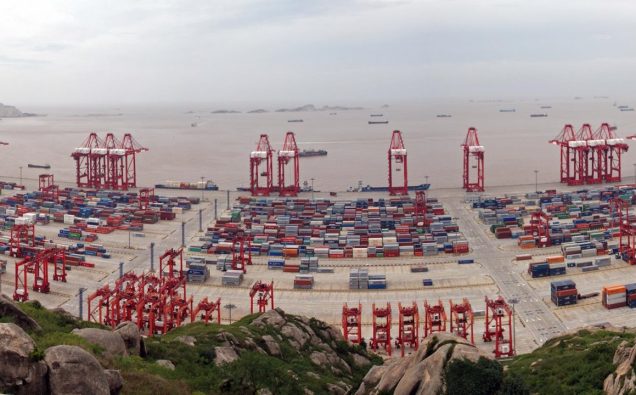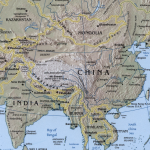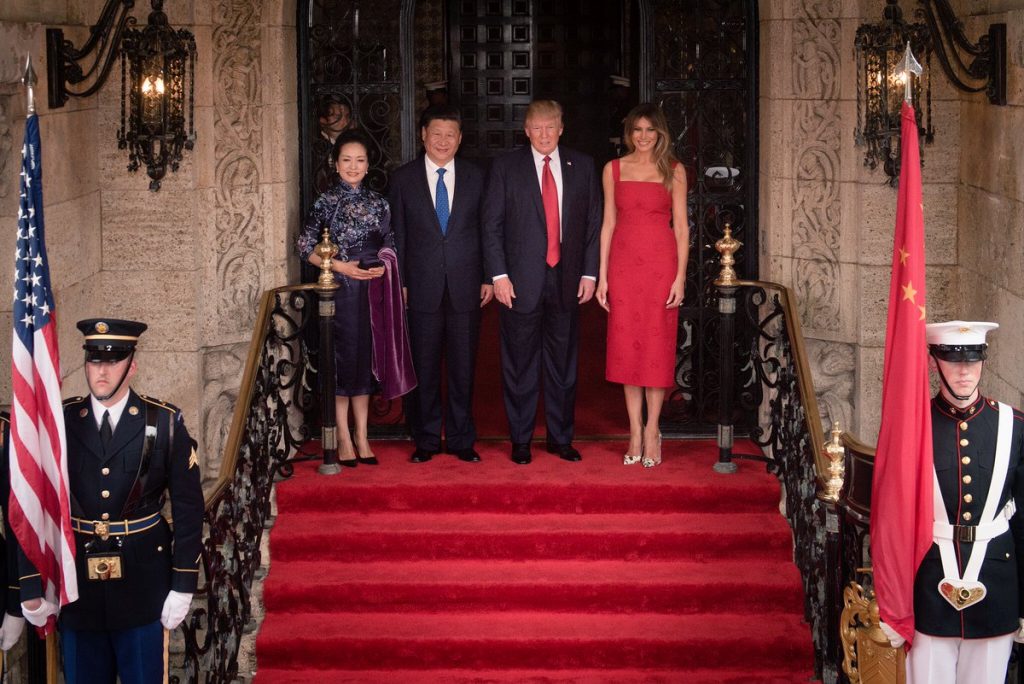
The Port of Shanghai in Yangshan Island Photo by Bigg(g)er/Wikimedia Commons
The Mongols Yuan dynasty (1279-1368) ruled over China when the Great Kublai Khan – grandson of Genghis Khan – conquered China. But as they entrenched into the power their empire got weaker and due to the long span of prosperity, the Mongols became laid back and over confident. In 1352, when the terrible flood struck parts of China they were unable to handle the people’s reaction to the widespread diseases and deaths. The Yellow River waters submerged huge areas of farmland, eradicated. The widespread famine and diseases caused by the flood incited the uprising among the peasants around Guangzhou on the Pearl River delta, who were already impatient because of the accesses of the Mongol warlords.
In 1368, the leader of the uprising, Zhu Yuanzhang entered the Mongol empire capital Ta-tu (now Beijing) and forced the Mongol emperor Toughen Temur to flee from the capital. The uprising leader Zhu Yuanzhang proclaimed the new dynasty – The Ming dynasty – and declared himself as the first emperor of the dynasty.
Until the 9th century AD, the Chinese fleets which travelled outside its maritime boundaries were mostly the foreign made ship. However, after the 9th century, the ships were built inside China. The Song dynasty (960-1279) and Mongol Yuan dynasty (1279-1368) maintained their own fleets and built substantial foreign trade. The third Ming Emperor, Zhu Di – the younger son of Zhu Yuanzhang, who snatched the power from his nephew, Zhu Yunwan in 1402 and moved the capital from Nanjing to Beijing – set his goal to create – what even the great Kublai Khan was failed to achieve – a maritime empire which would be spanning to vast oceans. He began to expand the Chinese fleet by adding – in the fleet of trade and warships he inherited – 1,681 new ships, among them 250, 9-masted treasure ships. In addition to the treasure ships, the fleet contained 1,350 patrol ships and the same number of small warships which were docked on the guard stations and the island bases. Besides that, the fleet also contained 400 large warships and another 400 freighters which were used to transport horses, food and water for the crew members.
With the huge fleet and technology, Zhu Di decided to mount lavish maritime expeditions to overwhelm the other empires by the Ming power. He chose his most trusted man – a devout Muslim and eunuch – Zhang He for this special purpose. Admiral Zhang He fleets visited Java, Thailand, Brunei, Southeast Asia, India, Africa and Arabia. He presented to different rules the gifts like silk, Chinese porcelain, gold, silver and received the gifts from them and took them to China. However, according to a bestseller by Gavin Menzie — a British author and retired submarine lieutenant-commander – Admiral Zhang He went to as far as Africa, Australia, New Zealand and North and South America on his 6th voyage in 1421. Some historians disagree with this account of Menzie’s narration.
In 1421, just two months after admiral Zhan He’s armada set sail for the sixth voyage to the western and southern sea, a violent storm broke over the Forbidden City – which was built and inaugurated just months before in the presence of many dignitaries and rulers of the world. Not only the emperor’s throne was burnt, but his favorite concubine was also killed in the fire caused by the storm. Chinese emperors believe that they are the rulers because they had mandates of Heaven. The way the lightning struck and caused the arson and it coincided with the unknown epidemic in which over 174,000 lives were perished in Fujian, Zhu Di believed that it was a signal of Heaven to him to step down. He temporarily stepped down and had his son take care of day to day business. The people began telling him that the way he destroyed the woods to make the Forbidden City, gods got angry and punished him. Under such pressure he made some ill-conceived decisions, among those, a moratorium was imposed on all future voyages and suspended all the foreign travels.
During the peak of his power, Zhu Di used to run two administrations in his empire. The mandarin cabinet ran the finance, economy, home ministry and law and order, while the eunuchs were predominantly running the military and were the tools for Zhu Di to implement his foreign policy.
The mandarins did not like Zhu Di and his policies but during his peak, he tolerated not only them but turned a blind eye when they influenced his son. After the Forbidden City lightening incident, mandarins began to exploit the opportunity to further weaken the emperor. When the Mongol leader Arughati sensed the vulnerability of the emperor, he decided to refuse to pay the tributes to China. Zhu Di considered it an opportunity to show his power by leading the million men army and crush the uprising. His close and trusted aides tried to convince his not to go for such expedition, but Zhu Di arrested all who tried to bring some wisdom. As expected, Zhu Di’s expedition turned out to be a total disaster. Arughati disappeared and Zhu Di died while he was on the pursuit of Mongol leader. Zhu Di’s son Zhu Goazhi ascended the throne. He released all the ministers who were taken in custody by his father and he kept the embargos on the foreign travel and future voyages. Zhu Goazhi died just two years after inheriting the throne and his son Zhu Zhangji became the emperor. Zhangji intensified his father’s policies and imposed ban on foreign trade. After his death in 1435, a complete xenophobia took over the empire. Foreign trade was completely halted, learning and speaking foreign languages were prohibited. The shipyard was decommissioned and the populations were moved inland – away from the coastal area. All the record of voyages of Zhang He were destroyed and the admirals, who led the long journeys in vast oceans were humiliated. The Qing dynasty which succeeded the Ming dynasty in 1644, further brought the empire into the isolation, they even destroyed and burnt the 700 by 30 miles trade zone in the southern coast and threw China in the deep isolation for the centuries to come.
Gavin Menzie in his famous book, “1421, The Year China Discovered America”, wrote, “The colonies established in Africa, Australia, New Zealand and North and South America were abandoned and left to their fate. By late 1421, China’s history was set for centuries to come. The legacy of Zhu Di, Zheng He, and their great treasure fleets would be all but obliterated. The ships that had made those voyages were left to rot and were never replaced. The logs and records were destroyed and the memory of them expunged so completely over the succeeding decades as if they had never existed. As China turned its back on its glorious maritime and scientific heritage and retreated into a long, self-imposed isolation from the outside world, other nations took up the torch. But all their explorers, colonizers and discoverers voyaged in the long shadows cast by Zhu Di’s fleets.”
Today, China’s One-Belt-One-Road program and its aggressive stance inside the South and East China sea is seen by some as a policy of expansion of Chinese influence and a way to assert control over – far from its maritime boundaries – its west and east.The aggressive plan to build a so-called Economic Corridor, the CPEC, (China-Pakistan Economic Corridor) and building a huge port with the maximum cargo handling capability as high as the Dubai port is seen by the West and by the critiques of CPEC in Pakistan, as China’s attempt to create a “West Coast” for itself which will not only reduce its maritime route but also remove its dependence on the 1.5 knots wide Strait of Malacca.
There is very little criticism on CPEC in Pakistan because in Pakistan it is called as the “game changer” and after China, Pakistan will be the biggest beneficiary in the future. However, India sees it as a future threat. Although, India is questioning the route because it is passing through the Gilgit-Baltistan region, which India considers a disputed land, but its main concern is China’s presence in the Arabian Sea which is used by India as a path way to transport its oil from the Persian Gulf through the strait of Hurmuz.
This will significantly curtail India’s vision to have complete control on the Arabian Sea and diminish its ability to impose the Naval blockade against Pakistan if it chooses to.
In the east, the territorial disputes over a handful of islands of the East and the South China Sea have already strained relations between China and countries which have the coasts in South China Sea (Philippines, Vietnam, Taiwan, Malaysia, and Brunei) in recent years. The South China Sea region is the area that is the home to a wealth of natural resources, fisheries, trade routes, and military bases.
The Ministry of Geological Resources and Mining of the People’s Republic of China estimates that the South China Sea contains 126 billion barrels of crude oil (compared to Kuwait which has some 93 billion barrels of crude oil reserves), although, other sources claim that the reserves of oil in the South China Sea may be about 7.9 billion barrels. All of this is at stake in the increasingly frequent diplomatic — and sometimes low-intensity military — impasse among the countries of the region. Although the United States does not openly support any party in the region openly, however, it has significant political, security, and economic interests over the issue of freedom of navigation in China’s 200 miles Exclusive Economic Zone (EEZ), in which, the U.S. considers it has a right to operate its military vessels. The tension between U.S. and China is shaping not only due to the Chinese insecurity about its territorial and maritime limits but it is also due to the anxiety in Washington about the China’s growing military power and its regional ambitions.
China also piling up the sand onto the underwater ledges in the South China Sea and creating small artificial islands. This action is causing strain in its relations with other countries in the region.
Now China and Russia are joining hands to tackle insecurity in Afghanistan and the terrorism at large. The latest international conference hosted by Moscow in April 2017 — the day after the US first time dropped its most powerful conventional bomb (MOAB) on a suspected ISIS hideout in Afghanistan — where 11 nations discussed ways of bringing peace to Afghanistan. The meeting was attended by Russia, China, Afghanistan, India, Pakistan, Iran, Kazakhstan, Kyrgyzstan, Tajikistan, Turkmenistan and Uzbekistan. The U.S. was invited but it decided to stay out of the moot. The US State Department spokesman Mark Toner said, “It seemed to be a unilateral Russian attempt to assert influence in the region that we felt wasn’t constructive at this time.”
The growing Chinese influence, not only around its territory but far out to the Indian Ocean, Middle-East and Sub-Saharan Africa may be a challenge and a matter of concern, especially for the West, but the world must learn to live in the era of the multipolar world.
But the growth of China would not diminish the importance of United States at the world stage. The U.S. will still be leading the world and even China would not want to damage its relations with Washington.
In the coming decades, the world is likely to witness a growing China but also a burgeoning partnership between United States and China.
The issue of South China Sea will be settled once China would get its sense of security. However, one question still remains unanswered. Is China once again expanding its influence by creating another maritime empire which would be spanning to the vast oceans and reopening the Silk Route to widen its impact on the world by land? Is a giant waking up after nearly 600 years of dormancy, marking an interesting and a crucial turn of the history?






![By Voice of America [Public domain], via Wikimedia Commons](https://www.viewsnews.net/wp-content/uploads/2016/07/South_China_Sea_claims_map-1-1024x924.jpg)














Way cool! Some extremely valid points! I appreciate you penning this post plus the rest of the website is really good.
I’ve learn a few excellent stuff here. Certainly value bookmarking for revisiting. I wonder how so much attempt you put to create this kind of wonderful informative web site.
I love your blog.. very nice colors & theme. Did you design this website yourself or did you hire someone to do it for you? Plz answer back as I’m looking to construct my own blog and would like to find out where u got this from. appreciate it